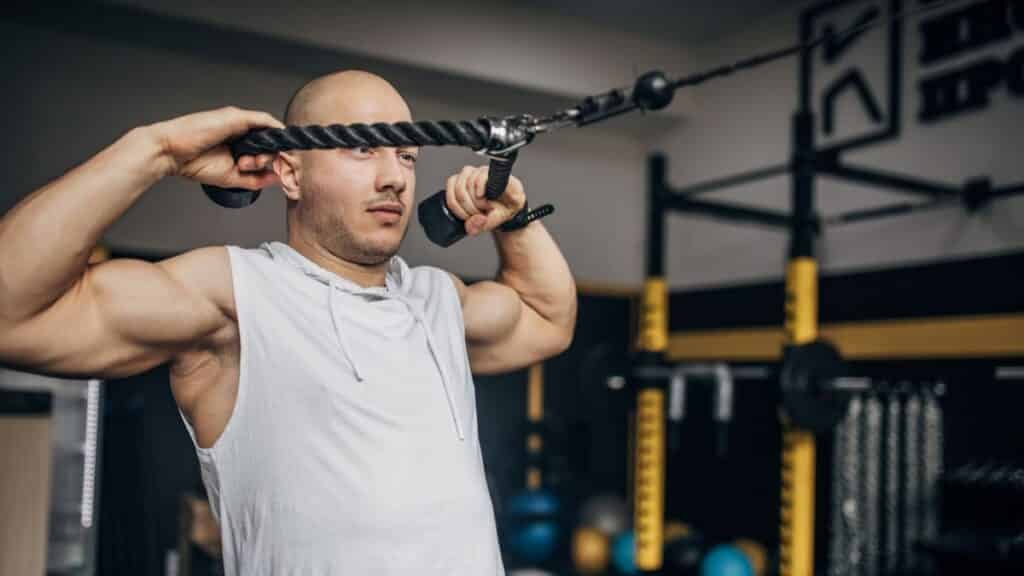Share on
Face pulls – the unsung heroes of shoulder health and postural balance. If you’re looking to take your upper body workouts to the next level, it’s time to get acquainted with this game-changing exercise. In this comprehensive guide, we’ll dive deep into the world of face pulls, exploring proper technique, variations, and the incredible benefits they offer. So, grab your resistance bands or head to the cable machine, and let’s get pulling!
Key Takeaways
- Face pulls target the rear delts, rhomboids, external rotators, and lower traps
- Proper form involves keeping elbows at shoulder level and focusing on external rotation
- Variations include using different equipment, anchor heights, and grip positions
- Regular incorporation of face pulls can improve posture and overall shoulder health

What are face pulls?
Face pulls are a strength training exercise that primarily targets the muscles of the upper back and shoulders. The movement involves pulling a cable or resistance band towards your face, hence the name “face pulls.” While the exercise may seem simple, it packs a powerful punch when it comes to balancing out your shoulder development and improving posture.
This exercise has its roots in the world of bodybuilding and strength training, gaining popularity as a complementary exercise to pressing movements like the bench press and overhead press. By targeting the often-neglected rear deltoids and upper back muscles, face pulls help create a well-rounded physique and reduce the risk of muscular imbalances.
Muscles targeted by face pulls
When performed correctly, face pulls engage a variety of muscles in the upper body, including:
- Rear deltoids: The posterior portion of the shoulder muscles
- Rhomboids: The muscles between the shoulder blades that help retract the scapula
- External rotators: The infraspinatus and teres minor, which rotate the shoulder outward
- Lower trapezius: The lower portion of the trapezius muscle, responsible for scapular depression and retraction

Importance of face pulls in a workout routine
Incorporating face pulls into your workout routine offers numerous benefits. First and foremost, they help balance out the development of your shoulder muscles. Many people focus heavily on pressing movements, which can lead to overdeveloped front deltoids and pecs. Face pulls counteract this by targeting the rear deltoids and upper back, creating a more balanced and aesthetically pleasing shoulder profile.
Moreover, face pulls contribute to improved posture by strengthening the muscles responsible for maintaining proper shoulder alignment. In today’s world of prolonged sitting and hunching over devices, this exercise can be a game-changer in combating the negative effects of poor posture.

Proper Form and Technique
Setting up for face pulls
To perform this exercise, you’ll need either a cable machine with a rope attachment or a resistance band. If using a cable machine, set the pulley to upper-chest height. This allows for optimal engagement of the target muscles. Attach a rope handle or a tricep rope to the pulley. If using a resistance band, secure it to a sturdy anchor point at a similar height.
When setting up for face pulls, adopt a shoulder-width stance with your feet firmly planted on the ground. Maintain a slight bend in your knees and keep your core engaged throughout the movement.
Step-by-step guide to performing face pulls
- Grasp the rope or band with an underhand grip, palms facing each other. You can also use a pronated (overhand) or supinated (underhand) grip on a tricep rope for variation.
- Take a step back to create tension in the cable or band. Your arms should be extended in front of you, with a slight bend in your elbows.
- Initiate the movement by retracting your shoulder blades and pulling the rope or band towards your face. Focus on external rotation of your shoulders, bringing your elbows out to the sides.
- Keep your elbows at shoulder level throughout the movement. Avoid letting them drop or flare up too high.
- As you pull the rope or band towards your face, concentrate on squeezing your shoulder blades together and maintaining a tall spine.
- Pause briefly at the end of the movement, feeling the contraction in your rear deltoids and upper back muscles.
- Slowly return to the starting position, maintaining control of the weight or resistance.
- Repeat for the desired number of repetitions.
| Muscles Targeted | Primary Movement | Secondary Movement |
|---|---|---|
| Rear Deltoids | Shoulder Extension | External Rotation |
| Rhomboids | Scapular Retraction | – |
| External Rotators (Infraspinatus, Teres Minor) | External Rotation | – |
| Lower Trapezius | Scapular Depression | Scapular Retraction |
Common mistakes to avoid
While face pulls may seem straightforward, there are a few common mistakes to watch out for:
- Using excessive weight: Resist the temptation to go too heavy. Face pulls are about proper form and muscle engagement, not moving the heaviest weight possible. Using too much weight can compromise your technique and lead to injury.
- Internal rotation of the shoulders: Focus on externally rotating your shoulders as you pull the rope or band towards your face. Internal rotation can place undue stress on the shoulder joint and diminish the effectiveness of the exercise.
- Improper elbow positioning: Keep your elbows at shoulder level throughout the movement. Letting them drop too low or flare up too high can shift the emphasis away from the target muscles.
- Neglecting scapular retraction: Remember to actively squeeze your shoulder blades together as you perform face pulls. This ensures proper engagement of the rhomboids and lower trapezius muscles.
Variations and Equipment
Cable machine variations
- Standard face pull: The classic version of the exercise, performed with a rope attachment on a cable machine at upper-chest height.
- High-to-low face pull: Set the pulley to a higher position, above head level. This variation places greater emphasis on the lower trapezius muscles.
- Low-to-high face pull: Set the pulley to a lower position, around waist height. This variation targets the upper portions of the rear deltoids and trapezius muscles.
- Single-arm face pull: Perform the exercise with one arm at a time, using a single-handle attachment. This allows for unilateral work and can help address muscle imbalances.
Resistance band variations
- Standing face pull: Anchor a resistance band at upper-chest height and perform the exercise as you would with a cable machine.
- Seated face pull: Sit on a bench or the floor with the resistance band anchored at upper-chest height. This variation can help maintain a stable torso position.
- Floor face pull: Anchor the resistance band at a lower height and sit on the floor with your legs extended. This variation places a greater emphasis on the posterior chain muscles.
Grip and stance variations
- Rope attachment vs. straight bar: While a rope attachment is the most common choice for face pulls, you can also use a straight bar for a slightly different grip and emphasis.
- Underhand vs. overhand grip: An underhand grip (palms facing each other) is generally recommended for face pulls, as it promotes external rotation of the shoulders. However, you can also use an overhand grip (palms facing down) for variety.
- Square stance vs. staggered stance: A square stance, with feet shoulder-width apart, is the default position for face pulls. However, you can also use a staggered stance (one foot slightly in front of the other) to add variety and challenge your stability.

Benefits and Importance of Face Pulls
Muscle development and strengthening
Face pulls offer a targeted approach to developing the muscles of the upper back and shoulders. By placing a direct emphasis on the rear deltoids, rhomboids, external rotators, and lower trapezius, face pulls help create a balanced and well-rounded physique.
The rear deltoids, in particular, are often overlooked in many training routines. Face pulls provide an effective way to isolate and strengthen these muscles, which play a crucial role in shoulder health and stability.

Postural improvements
In today’s world of prolonged sitting and hunching over devices, poor posture has become a prevalent issue. Face pulls can be a powerful tool in combating the negative effects of poor posture by strengthening the muscles responsible for maintaining proper shoulder alignment.
By targeting the rhomboids and lower trapezius muscles, face pulls help counteract the forward pull of the chest and front deltoid muscles. This can lead to improved posture, reduced neck and shoulder pain, and a more confident appearance.
Injury prevention and rehabilitation
Face pulls play a vital role in injury prevention and rehabilitation, particularly when it comes to the shoulder joint. By strengthening the rotator cuff muscles (external rotators) and the muscles that stabilize the scapula, face pulls can help reduce the risk of common shoulder injuries such as impingement syndrome and rotator cuff strains.
For individuals recovering from shoulder injuries, face pulls can be a valuable addition to their rehabilitation program. The exercise helps restore balance and strength to the affected muscles, promoting a safer and more efficient return to full activity.
Performance enhancement
Incorporating face pulls into your training routine can also lead to improved performance in other exercises and daily activities. By strengthening the muscles responsible for shoulder stability, face pulls can enhance your ability to perform pressing movements, such as the bench press and overhead press, with better form and control.
Moreover, the postural benefits of face pulls can translate into improved performance in sports and other physical activities. Better posture and shoulder alignment can lead to more efficient movement patterns, increased power output, and reduced risk of injury.

Programming Face Pulls into Your Workout
Frequency and volume
To reap the full benefits of face pulls, it’s recommended to incorporate them into your workout routine 2-3 times per week. Aim for 3 sets of 10 repetitions, focusing on proper form and muscle engagement.
As with any exercise, it’s essential to start with a weight or resistance that allows you to maintain proper technique throughout the entire range of motion. As you become more comfortable with the movement, gradually increase the weight or resistance to continue challenging your muscles.
Placement in workout routine
Face pulls can be incorporated into your workout routine in several ways:
- As a warm-up exercise: Performing a few sets of face pulls with light weight or resistance can help activate and prepare your shoulder and upper back muscles for more intensive exercises.
- During upper body or pull workouts: Include face pulls as part of your upper body or pull-focused training sessions. They pair well with other exercises targeting the back and shoulders, such as rows, pull-ups, and rear delt flies.
- As part of a shoulder prehab/rehab routine: If you’re looking to prevent or recover from shoulder injuries, consider incorporating face pulls into your prehab or rehab program. They can help strengthen and stabilize the shoulder joint, reducing the risk of future issues.

Progressive overload strategies
To continue making progress and seeing results from face pulls, it’s important to employ progressive overload strategies. This involves gradually increasing the demand placed on your muscles over time. Some effective ways to progressively overload with face pulls include:
- Increasing resistance: As your strength improves, gradually increase the weight or resistance used for face pulls. This can be done by using a heavier band or increasing the weight on the cable machine.
- Manipulating tempo and time under tension: Experiment with different tempos and rep ranges to vary the time under tension. For example, perform slower, more controlled reps to increase the duration of each contraction, or incorporate pauses at the peak of the movement to emphasize the squeeze.
- Incorporating advanced variations: As you master the basic face pull technique, try incorporating more advanced variations into your routine. This can include single-arm face pulls, face pulls with external rotation, or face pulls with a resistance band while sitting on a stability ball.
Tips for Maximizing Face Pull Effectiveness
Mind-muscle connection
Developing a strong mind-muscle connection is crucial for maximizing the effectiveness of face pulls. Focus on actively engaging the target muscles throughout the movement, visualizing the rear deltoids, rhomboids, and upper back muscles contracting with each rep.
One helpful visualization technique is to imagine squeezing a pencil between your shoulder blades as you perform the exercise. This can help reinforce the idea of scapular retraction and improve muscle activation.
Proper weight selection
Choosing the appropriate weight or resistance for face pulls is key to ensuring proper form and targeting the desired muscles. If the weight is too heavy, you may compromise your technique and risk injury. On the other hand, if the weight is too light, you may not provide sufficient stimulus for muscle growth and strength development.
A good rule of thumb is to select a weight that allows you to complete the desired number of repetitions with proper form, while still challenging your muscles. If you find yourself struggling to maintain good technique or experiencing pain, reduce the weight or resistance. Conversely, if you can easily perform more than the intended number of reps without fatigue, consider increasing the weight.
Form check and adjustments
Regularly assessing your face pull technique is essential for ensuring you’re targeting the correct muscles and minimizing the risk of injury. One helpful tool is to use mirrors or video recording to observe your form from different angles. This can help you identify any misalignments or deviations from proper technique.
If you have access to a training partner or coach, ask for feedback on your form. They may be able to spot issues that you can’t see or feel yourself, and provide cues to help you make the necessary adjustments.
Some common form cues to keep in mind during face pulls include:
- Keeping your core engaged and maintaining a tall spine
- Focusing on external rotation of the shoulders
- Squeezing your shoulder blades together at the peak of the movement
- Avoiding excessive momentum or jerky motions
Conclusion
Face pulls are a valuable addition to any well-rounded strength training program. By targeting the often-neglected muscles of the upper back and shoulders, face pulls contribute to balanced muscle development, improved posture, and enhanced shoulder health.
Throughout this comprehensive guide, we’ve explored the proper technique for performing face pulls, as well as various modifications and progressions to keep your workouts engaging and challenging. By incorporating face pulls into your routine and focusing on proper form, you can unlock a host of benefits, from injury prevention to improved athletic performance.
Remember, consistency is key when it comes to seeing results. Make them a regular part of your training regimen, and you’ll be well on your way to stronger, healthier shoulders and a more confident posture.



Thank you for the good writeup It in fact was a amusement account it Look advanced to far added agreeable from you However how could we communicate